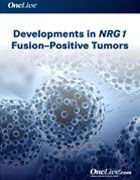Publication
Article
Special Issues
Afatinib Shows Potential in NRG1-Positive Gastrointestinal Cancers
Author(s):
Benjamin Weinberg, MD, provides insight into NRG1 fusions, the effectiveness of afatinib in patients harboring these fusions, and future research being done in NRG1 fusion–positive gastrointestinal cancers.
Benjamin Weinberg, MD

Benjamin Weinberg, MD
New case reports show that afatinib (Gilotrif) may be a potential treatment option for patients with rare NRG1 fusion—positive gastrointestinal (GI) cancers, said Benjamin Weinberg, MD, especially if given earlier on in the treatment course.
“Afatinib is an oral ErbB family-blocker; it is FDA approved for use in subsets of patients with advanced non—small cell lung cancer (NSCLC),” added Weinberg. “The idea is that these NRG1 fusions lead to overactivation of the ErbB pathway, which then leads to activation of cellular proliferation signaling pathways. By blocking this fusion product on the cell surface and preventing homo- or heterodimerization of the ErbB dimer, you are blocking the downstream signal that leads to cellular growth.”
Weinberg and colleagues reported findings from 3 new cases of afatinib treatment in patients with NRG1 fusion—positive GI cancers at the 2019 World Congress on Gastrointestinal Cancer. Of the 3 cases, 1 patient had KRAS-mutant metastatic colorectal cancer (CRC), while the other 2 patients had KRAS wild-type metastatic pancreatic cancer.
Although the overall frequency of NRG1 fusions across all solid tumor tumors is only about 0.2%, their prevalence can rise as high as 30% in certain subgroups of patients, according to Weinberg. As such, the oncology community must be aware of its existence—the fact that it’s a potentially actionable target—and that comprehensive genomic profiling is critical in order to detect them early.
“The more targets we find, the more we have to test for,” said Weinberg. “It’s important for our patients that even if we find a ‘needle in the haystack,’ it could be a ‘silver bullet’ and that really could impact their treatment course.”
In an interview with OncLive, Weinberg, an assistant professor of medicine, Division of Hematology and Oncology, in the Lombardi Comprehensive Cancer Center at Georgetown University, Medstar Health, provided insight into NRG1 fusions, the effectiveness of afatinib in patients harboring these fusions, and future research being done in this area.
OncLive: What is known thus far about the rare gene fusion NRG1?
Weinberg: NRG1 encodes for neuregulin 1, a growth factor that binds to receptor pathways known as the HER or ErbB pathway. It specifically binds to HER3 and HER4 and activates downstream signaling pathways that lead to cellular growth and proliferation. Gene fusions occur when NRG1 basically combines with another gene that allows it to be activated.
NRG1 fusions have been implicated rarely but can play a role in a variety of solid tumors. They’re very rare; their overall frequency is about 0.2% across all solid tumors. However, in some select subgroups of solid tumors, their prevalence can jump as high as 30%. [This target] is of special interest because there is a series of drugs in development, like afatinib, that are panHER-blocking drugs that can theoretically work in these cancer types.
Could you discuss the data with afatinib in patients with GI cancers harboring NRG1 fusions?
Our interest was specifically in GI tumors. We wanted to see if [these patients] have the NRG1 fusion and if we can target it with a drug such as afatinib. At the 2019 World Congress of Gastrointestinal Cancers, Meeting, we presented 3 cases. One of them was my patient, a gentleman with metastatic KRAS-mutated CRC, and the other 2 were patients with metastatic pancreatic cancer who were KRAS wild-type, which is a rarer form of metastatic pancreatic adenocarcinoma.
My patient with KRAS-mutated CRC is an older gentleman who initially presented with a right-sided colon cancer that was bleeding. He underwent surgical resection, despite multiple liver lesions being present at the time of diagnosis. He did not tolerate chemotherapy very well and ultimately had a liver resection followed by low-dose chemotherapy, and then, ultimately, lung resections for metastatic cancer.
Around that time, he was discovered to have a novel NRG1—POMK fusion that was identified through a KRAS molecular profile. Afatinib was initiated in [this patient] September of last year and he remains on the drug, 10 months later. He had stable disease, initially declined in his carcinoembryonic antigen blood tumor marker—which subsequently uptrended—and then he got local radiation therapy to a couple of metastatic sites with improvement in his scan and numbers. He remains on the drug with overall stable disease following isolated areas of progression. He’s tolerating the drug better than any chemotherapy he received.
The other patient, the one with KRAS wild-type metastatic pancreatic cancer, was a younger gentleman who had liver metastases at diagnosis, had 1 line of chemotherapy that he stopped for intolerance—gemcitabine and nab-paclitaxel (Abraxane)—and then was started on afatinib for an NRG1—ATP1B1 fusion that was identified. He had tumor shrinkage, a significant radiological response, and he remains on afatinib 7 months later with an ongoing response.
And the other patient, a similar middle-aged gentleman with metastatic KRAS wild-type pancreatic cancer with liver metastases at diagnosis, received 2 lines of standard chemotherapy—FOLFIRINOX and then gemcitabine. He also had a partial response on 40 mg of afatinib. His dose was then reduced and he had disease progression following 5.5 months. He ultimately died of progressive disease thereafter.
[Afatinib] seems to be a little [more effective] if it’s given earlier on in the treatment schema, if we can identify these NRG1 fusions earlier. In order to find these [fusions] you really have to do whole-genome transcriptome analysis or pretty broad next-generation sequencing on solid tumor tissue; it’s not something that’s easily picked up in liquid biopsies and the like. This especially needs to be done in order to detect these novel fusion partners—such as my patient who had the NRG1—POMK fusion—that fusion product hasn’t been seen before or since. Without doing whole-transcriptome sequencing, you are probably going to miss those types of findings.
He’s also the only patient with CRC in the 1700 patients that were tested who had an NRG1 fusion of any type, so [this fusion] is pretty rare, but it obviously is a potentially clinically actionable [target].
Were there any notable associated toxicities with afatinib? How did you manage them?
The big ones with afatinib are diarrhea and then a rash. However, I find that at the 30-mg daily dose, the agent is actually very tolerable. The 40-mg daily dose can be harder to tolerate. The second patient with pancreatic cancer [that I described] had to have a dose reduction from 40 mg daily to 30 mg daily due to diarrhea. [The first patient described], my patient, has always had some degree of baseline diarrhea and he did have a mild rash on the drug, but we never had to hold the drug or decrease the dose. Therefore, I believe that the 30-mg daily dose is tolerable, and I don’t think that there is a big difference in terms of efficacy between the 2 dose levels, although that is always a question.
What are the next steps with this research?
We are trying to include afatinib or other HER-targeting drugs in basket trials, where we can test a large population [for the fusion]. If we find an NRG1 fusion, there is a sort of slot of patients who would then get exposed to afatinib.
There are other drugs in development as well. For example, there’s a drug called tarloxotinib, which conceivably can be even more potent and deliver a higher level of HER blockade to the tumor. This may be a rare, but potentially actionable type of target with the right drug in the right patient. As such, [NRG1 is] another [target] that we really need to be looking for.
Is the importance of this fusion and its detection widespread knowledge in the community?
I don’t know how well-known this is in the broader community, but it’s a relatively recently [learned] phenomenon. The other best example is the NTRK story, which now has an FDA-approved drug called larotrectinib (Vitrakvi). NTRK fusions are seen very rarely across solid tumors, but at a higher rate than some pediatric tumors. We have an FDA approval for patients who have an NTRK gene fusion.
[NRG1] may be a kind of similar story, as it’s a rare but potentially actionable fusion that we need to be looking for. It is important to improve awareness so that oncologists don’t just discard this information thinking, “Oh, it’s an NRG1 fusion, no big deal.” They need to know that it could be a potentially actionable target.
Could you speak to the ASCO TAPUR trial and the NRG1 arm that is recruiting patients?
What is your take-home message regarding personalized medicine and the need for molecular testing in GI cancers?
The more these [rare fusions] pop up, the more we’re going to need to do comprehensive genomic profiling to find them, and to only test for a few actionable mutations probably isn’t enough. In fact, it’s probably doing a disservice to our patients, because the more we look for these rare entities, the more we find them.
Weinberg B, Renouf D, Lim H, et al. NRG1—fusion positive gastrointestinal tumours: afatinib as a novel potential treatment option. Ann Oncol. 2019;30(suppl 4, abstr P-291). doi: 10.1093/annonc/mdz155.290.
That would be an example of a basket trial where patients theoretically could get access to the drug if they meet the inclusion criteria and have an actual NRG1 fusion. That is one mechanism by which patients could get access to the drug from a clinical trial standpoint.










